Background
Considering wheelchair seating measurements vary from seated anthropometrics, a standardized method for this measurement was needed. ISO 7176-7 describes the measurement of wheelchairs and seating systems. Selecting a wheelchair might become confusing due to manufacturers reporting measurements and seating dimensions in different ways (Cooper, 1995). It is important to use standard measurements that can be relevant to technicians, clinicians, and the users, particularly in a manual wheelchair as these can be used to fit the wheelchair to a user (Ammer, n.d.).
Purpose
To specify a method to measure seating and wheel dimensions in a wheelchair (ISO, 1998).
Principle
To maintain consistency of wheelchair measurements across manufacturers and models of wheelchairs. The wheelchair should be loaded when taking measurements to simulate dimensions when it is occupied (Cooper, 1995).
Apparatus
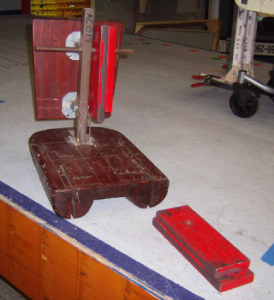
Figure adapted from (Ammer, n.d.).
Reference Loader gage (RLG): It consists of a seat and back portions hinged together, and two curved sections to simulate legs. Weights are added to it to simulate the weight distribution of a user. The RLG is used to create reference planes and serve to form a basis to take seating measurements (Cooper, 1995).
Measuring tools for linear and angular dimensions
Test set up
Remove the seat and back cushions for this test, but keep all components for its regular use as recommended by the manufacturer.
Place the reference loader gauge (RLG) in the wheelchair seat before taking measurements. The figure below shows a power wheelchair with the RLG.
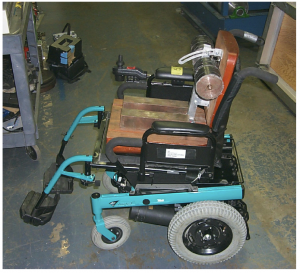
Figure adapted from (Rentschler, 2002).
Measurements
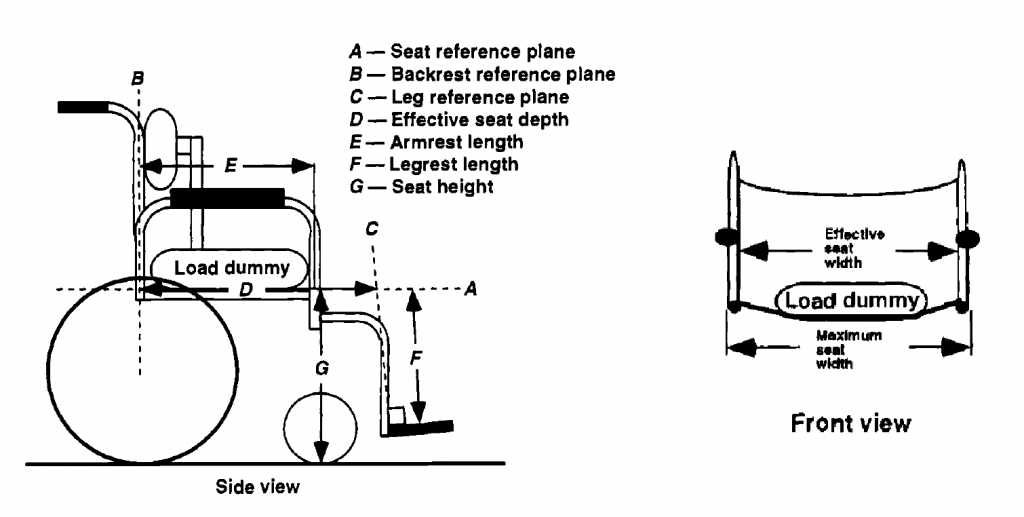
Figure modified from (Cooper, 1995).
For specific details on how to take these measurements based on the reference loader gauge, we recommend you obtain ISO 7176-7. For copyright reasons, we are providing the definition available on the literature that refers to these measurements.
Seat Plane angle
The angle of the seat with respect to the horizontal (Waugh & Crane, 2013). It represents the angle made by the base of the RLG and the horizontal. When the seat is tilted towards the back support, the seat angle is positive (Cooper, 1995).
Effective seat depth
The seat depth refers to the full seating depth available which is measured from the loaded backrest (RLG) to the intersection of the seat and lower leg reference plane (Cooper, 1995; Waugh et al., 2013). In other words, it is the distance between the backrest to the most forward point of the seat contact area (Waugh et al., 2013).
Seat width
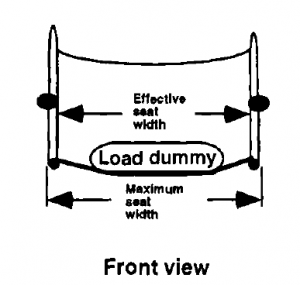
Figure adapted from (Cooper, 1995).
Linear distance measured between the lateral edges of the seat contact surface. Measure along the centerline or the midpoints of both edges.
Effective seat width
It refers to the distance between the lateral supports (Waugh & Crane, 2013). See figure in Seat width.
Seat height
The vertical distance from the front edge (top) of the loaded seat to the floor. This measurement can affect transfers, foot propulsion, weight distribution, and maneuverability (Cooper, 1995).
Back support angle
The back support angle, or backrest angle, is the angle formed relative to the vertical. Report a positive backrest angle when the back support is tilted to the end of the wheelchair.
Back support height
The distance from the top center of the seat to the top of the loaded backrest upholstery (Cooper, 1995; Waugh et al., 2013).
Back support width
The distance between the most lateral edges of the backrest (including the supporting structure and hardware) (Waugh et al., 2013).
Head support height
The distance is taken from the seat reference plane to the top of the head support (Waugh & Crane, 2013).
Seat surface to Foot support
Distance from the front edge (top) of the seat to the contact surface of the foot support at the back edge (Waugh & Crane, 2013).
Foot support clearance
Measure vertically, the distance from the test plane to the lowest part of the footrest (Waugh et al., 2013).
Foot support length
Also known as foot support depth, it is defined as the distance from the front to the back edge of the foot support (Waugh & Crane, 2013).
Foot support to leg angle
The angle between the foot support reference plane to the lower leg support (Waugh & Crane, 2013).
Leg to seat surface angle
The angle between the lower leg support reference plane and the seat (Waugh & Crane, 2013).
Arm support (armrest) height
Distance between the top of the seat and the top of the armrest (Waugh & Crane, 2013).
Arm support length
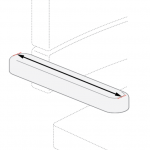
Figure adapted from (Waugh & Crane, 2013).
Also known as arm support depth, the distance from the back to the front edge of the armrest (Waugh & Crane, 2013).
Arm support width
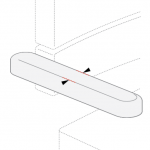
Figure adapted from (Waugh & Crane, 2013).
The distance between the most lateral edges of the armrest (Waugh & Crane, 2013).
Arm support angle
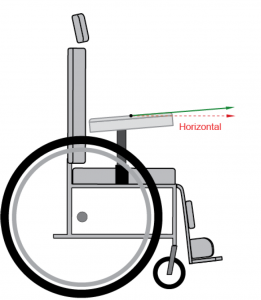
Figure modified from (Waugh & Crane, 2013).
The angle of the armrest relative to the horizontal (Waugh & Crane, 2013).
Distance between arm supports
The distance between the inner edged of the armrests (Waugh & Crane, 2013).
Handrim diameter
The outer diameter of the handrim (Waugh & Crane, 2013).
Propelling wheel diameter
Outer diameter of the wheel (Waugh & Crane, 2013).
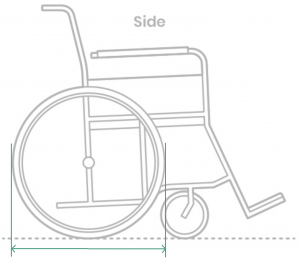
Figure modified from (Maddock, 2020).
References
Ammer, W. (n.d.). Testing a wheelchair with the RESNA standards and what the results can tell you. https://s3.amazonaws.com/dntstatic//2db35e72-a537-4452-5f65-6079d37f7401
Cooper, R. A. (1995). Rehabilitation engineering applied to mobility and manipulation / Rory A. Cooper. Institute of Physics Pub.
ISO. (1998). ISO 7176-7:1998(en) Wheelchairs—Part 7: Measurement of seating and wheel dimensions. https://www.iso.org/obp/ui/#iso:std:iso:7176:-7:ed-1:v1:en
Maddock, B. (2020, April 8). Wheelchairs. Dimensions.Guide. https://www.dimensions.guide/element/wheelchairs
Rentschler, A. (2002). Analysis of the ANSI/RESNA Wheelchair Standards: A Comparison Study of Five Different Types of Electric Powered Wheelchairs. University of Pittsburgh (Unpublished).
Waugh, K., & Crane, B. (2013). A Clinical Application Guide to Standardized Wheelchair Seating Measures of the Body and Seating Support Surfaces. University of Colorado/Assistive Technology Partners.
Waugh, K., Crane, B., Taylor, S., Davis, K., Cwertnia, S., Brown, L., Saftler, F., & Christie, S. (2013). Glossary of Wheelchair Terms and Definitions. University of Colorado, Assistive Technology Partners, through a grant from the Paralyzed Veterans Association.



